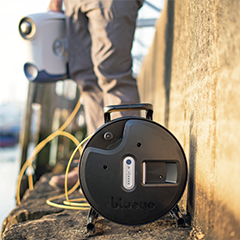Think of a future where the offshore wind supply chain connects in real time. Picture a wind turbine technician installing, maintaining, and fixing components with the support of shore-side staff connected through their eyes and ears. The experts are supporting the technicians through every step of a critical job.
Envision the crew of a CTV conducting an underwater visual inspection of the foundation and transition piece, then automatically storing the video footage. It is seamlessly uploaded to the cloud then quickly reviewed by the manufacturer engineering team. These capabilities are a reality through IoT technology, and they are available now.
A downtime event can cost millions of dollars and last days, sometimes weeks, where the wind turbine is not operating. An expert might need to fly in from another country to fix the problem. Not only is this costly and time consuming, but it also leaves a carbon footprint: a roundtrip flight from Logan International Airport in Boston to Heathrow, London, for example, emits approximately 1.53 tonnes of carbon dioxide into the atmosphere.
Now, imagine a trained technician putting on a pair of glasses that allow an entire resource team to see what he or she sees, and they can assess the problem from wherever they are in the world and potentially fix the problem.
This is how V2 Subsea is planning to disrupt the usual way of business in wind energy.
Dustin Varnell is a master mariner and dynamic positioning operator certified by The Nautical Institute. He has been working on offshore projects for over twenty years. Varnell is the founder of V2 Subsea, a technology solutions provider based in Newport, Rhode Island in the U.S.
V2 Subsea is using video and media technology in a new and innovative way to empower the offshore wind industry. ‘We are using video and data to complement enterprise systems like SMS (Safety Management Systems) and CMMS (Computerized Maintenance Management Systems). We see that this will significantly impact retaining knowledge and providing our customers with informed decision-making.’
Two years ago, Dustin began collaborating with a V2 Subsea partner organization called Blueye Robotics, a Norwegian company, to develop a solution that empowers ship’s crew, engineers, and scientists to conduct underwater inspections. The Blueye underwater drones can inspect anything from the ocean floor to a ship’s propeller.
‘We are working with Blueye Robotics to develop a reliable solution where anyone with basic training and experience can conduct underwater visual inspections,’ says Varnell. ‘Our partnership with Blueye fits with our goal of providing the best-in-class equipment for video and data capture.’ He continues.
This underwater robotic equipment is reliable, capable, and can operate down to 305 meters. The kit has already been used successfully on U.S. offshore wind farm sites for subsea inspection. Also, it is the fraction of the cost of a traditional work class ROV.
V2 Subsea also offers a globally accessible media platform that allows companies to store and categorize media for training and/or assessment purposes. ‘We design a customized and integrated program by use case for real-time communication and video data storage,’ says Varnell. ‘Our goal is to minimize the friction of video flow as a service.’ He continues.
This solution takes video and data sharing and collaboration beyond tools like email and Dropbox by simplifying the workflow, while openly integrating with existing software solutions to provide a single centralized secure source for digital assets.
Not too long ago, Varnell met Thomas Lougborough, a strategic market developer for RealWear at Innovate Newport, a co-working space and entrepreneurial hub on Aquidneck Island, where they both live. RealWear’s flagship product is the HMT-1®, a rugged, head-mounted, Android-class tablet computer.
Both Varnell and Lougborough saw an opportunity to implement the HMT-1® RealWear technology into remote inspections, where the operator could be streaming the video to an expert, thus creating a more efficient and cost-effective workflow for the industry.





















